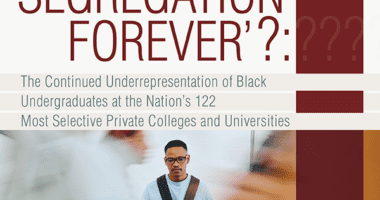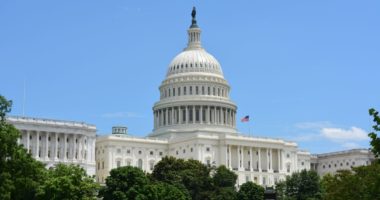The unfinished business of Brown v. Board of Education
(Washington, DC) On the eve of the 49th anniversary of the landmark Brown v. Board of Education decision ending legalized segregation in public schools, The Education Trust today released two reports documenting an educational system that is still very much separate and unequal.
The first report, “A New Core Curriculum for All,” marshals findings from several recent large-scale economic and education studies to argue that educators and policymakers working to ensure that all students are prepared for success in work and in college must attend, first and foremost, to ensuring that students take the kinds of rigorous courses that research makes clear are necessary for such success.
The report cites research showing that students of all sorts benefit when placed in higher level classes. Despite those benefits, the report finds that minority students are often not enrolled in upper-level classes. For instance, nationally, only one-half or fewer African American, Latino or Native American students are enrolled in Algebra II compared to nearly two-thirds of their White and Asian peers.
The second report, “Education Watch: Achievement, Attainment and Opportunity from Elementary School Through College” documents the continued academic segregation of low-income and minority students from other students. These state-by-state reports show that nationally and in almost every state, minority students are enrolled in lower level classes, are assigned to less-qualified teachers, and are disproportionately placed in special educationor suspended from school entirely.
“We now know that students dont have to be in legally segregated schools to be segregated into different classes and therefore very different futures. Frankly, many minority students still attend schools where there are few if any White students. But students can be in the very same school and receive two very separate and unequal educations,” said Kati Haycock, Director of The Education Trust on releasing the report.
Millions of high school students will be sent out into the “real world” in the coming weeks, looking to continue their education or find employment. Regardless of which path they have chosen, young people are gambling on the same thing that their high school diploma will prepare them to succeed. But thats not a safe bet.
“The research is clear and compelling: the single biggest predictor of success in college is the quality and intensity of a students high school curriculum more significant than test scores or class rank. In fact, these factors trump socio-economic status as an influence on student success,” said Patte Barth, the reports author.
Courses traditionally thought of as “college prep” are essential in todays workplace, where most jobs that pay a family-supporting wage demand high skills. “While a student with a high school diploma without higher-level classes such as Algebra II may get an entry-level job, he or she may end up sweeping the factory floor. Even in fields like manufacturing, students now need advanced courses in subjects like mathematics both to secure a foothold on the ladder and to gain real job security,” Barth noted. “The absence of college prep courses also cuts off their opportunity to choose later down the road to go back to school for additional training.”
“In view of all this, you would think that we would make sure that all students complete a rigorous academic core. After all, nobody loses. Yet we continue to give low-income and minority students less of the rigorous, demanding coursework they need,” said Barth.
Higher Educations Role Education Trusts Analysis of State Policies:
Few states have clear policies lining up what high schools require and what students need for college and work. In some cases, though, the problem starts in higher education, where there has been no statewide agreement on the curriculum that entering students need.
The state-by-state table on pages 10-12 in “A New Core Curriculum for All” shows the courses that states require for high school graduation alongside those required for entry to state postsecondary institutions. Clearly, for new high school graduates in many states, the high school diploma is no guarantee they meet postsecondary education course requirements.
“With nearly 75% of high school graduates nationwide enrolling immediately in some type of postsecondary education, we ought not be segregating any studentsbut especially low-income and minority studentsinto low-level classes. This kind of high school diploma is literally a ticket to nowhere,” added Haycock.
Achievement, Attainment and Opportunity Gaps in the States:
The Education Watch State Summary Reports include state-specific data on:
Achievement Gaps
- How many students are proficient in reading and mathematics on state assessments? How does achievement on state assessments compare with the states proficiency rates on NAEP?
- How do achievement gaps compare across states? Where are gaps the smallest? Where are they the biggest?
- In which states are minority students making the largest gains over time on NAEP?
- Are states making progress getting more students out of NAEPs below basic category and into basic or above?
Opportunity Gaps
- What are the participation and success rates for different groups of students in courses such as Advanced Placement?
- Who gets assigned to teachers who have a major or minor in their field?
Attainment Gaps High School and College Success
- Who makes it through high school?
- Who makes it through college?
Whats to be done?
Haycock and Barth call on K-12, higher education, business and policymakers to engage in meaningful K-16 efforts and take immediate action on putting into place a common default curriculum that will prepare students for success in both postsecondary and work, and provide it to all, not just some. They should first look at enrollments, achievement and attainment of their students and examine how resources, including qualified teachers, are distributed. With data in hand, policymakers, educators and communities must take action.
Specifically, they call for an action agenda that includes:
- States and districts putting into place a rigorous “default” high school curriculum;
- Higher education agreeing on a common definition of the skills students need to begin credit-bearing courses;
- Ensuring that all students have access to teachers who can provide instruction equal to the quality of content, and do more to increase the numbers and of such teachers; and
- Providing time and support for students to learn challenging content.









